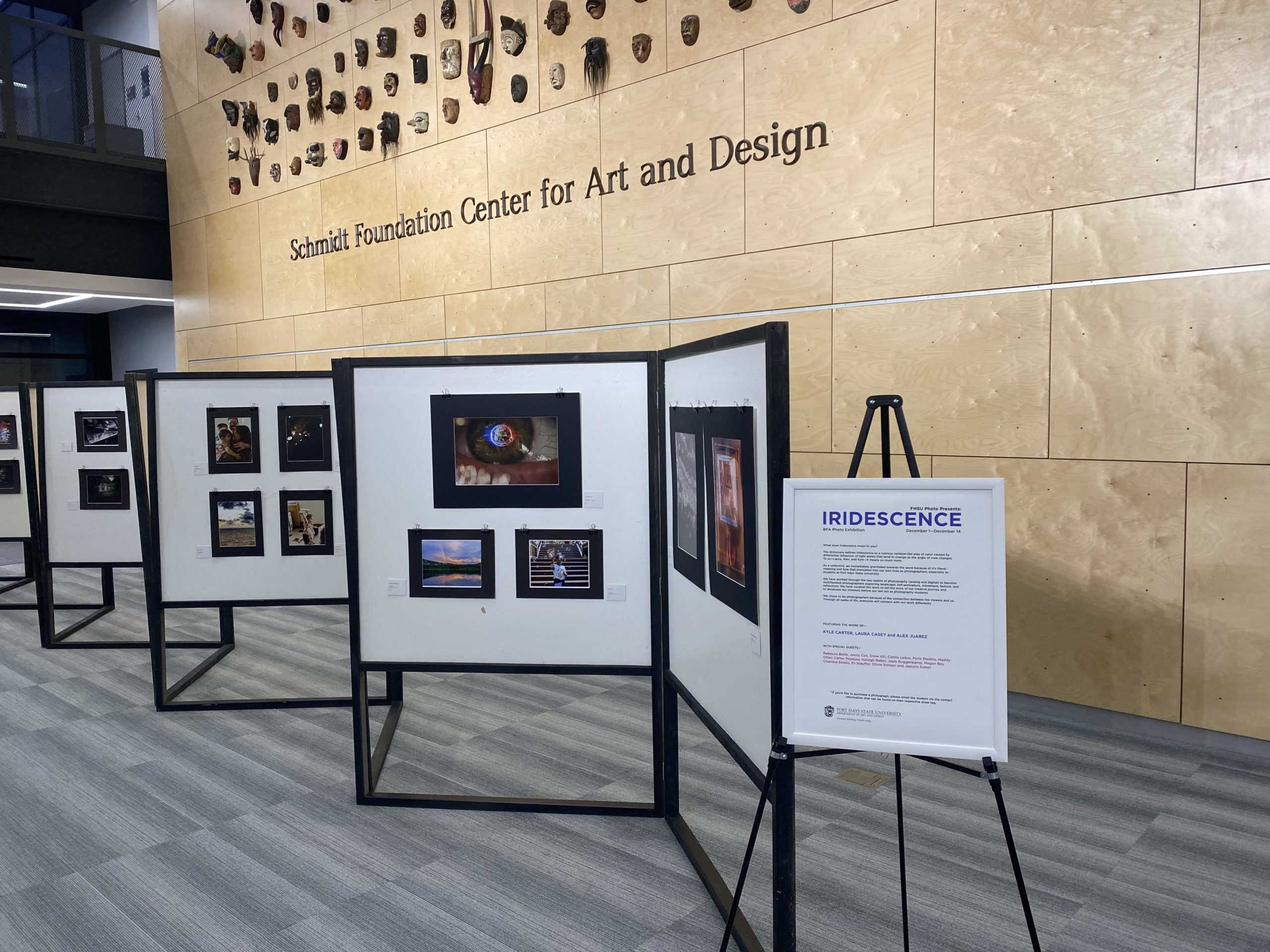BY CAITLIN LEIKER
FHSU students Kyle Carter, Laura Casey and Alex Juarez recently opened their BFA Photo Exhibition, Iridescence, in the Schmidt Foundation Center for Art and Design. The highlights of their photography journeys will be on display in the atrium until Dec. 14.
The three students have worked to become “multifaceted photographers” through landscape, self-portraiture, movement, texture, and reflections – all captured in digital and analog forms.
The gallery theme plays off of the title’s definition: “a lustrous rainbow-like play of color caused by differential refraction of light waves that tend to change as the angle of view changes.”

The point of the title was to bring focus to the vibrant colors and alternative perspectives in their works. Even in black-and-white images, iridescence can be communicated through lighting and a wide tonal range (the spectrum of darkest to brightest points in a work of art).
Alongside their photos, the three BFA students dedicated a section of their gallery to fourteen “Guest Artists”: Rebecca Bebb, Jenny Cox, Drew Hill, Caitlin Leiker, Perla Medina, Maddy Otter, Carter Popejoy, Haleigh Raber, Josie Roggenkamp, Megan Roy, Chandra Sotelo, PJ Staffer, Olivia Stinson and Jaelynn Sutter. These students represent a variety of majors who pursue photography independently or have taken FHSU’s darkroom photography course.
Carter said that the “Guest Artists” section is meant to showcase FHSU’s photography community, regardless of background.
“If you’re just starting out, or at the end of your career, any exposure is good,” Carter said. “A lot of the younger students coming in are very talented, and we need to shine as much light on them as possible.”
Casey said she wanted to pursue nursing before joining the Art and Design program. Her first Fort Hays photography experience was in the darkroom, when the arts were located in Rarick Hall.
“It’s been very fun, and I love this new building,” Casey said. “It’s the best thing in the world. A lot of photography departments in other schools around Kansas do not have a darkroom, so we’re very grateful to have one.”
Casey chose to explore portions of many disciplines, including both digital and analog photography, printmaking, ceramics, and graphic design.
Born and raised in Hays, the interactions with the community became one of her favorite parts of creating art. If she were starting over again, she would urge her younger self to experiment as much as possible. That was one of the biggest things that shifted her perspective.
Juarez also experienced a perspective shift when he first started photography. He said that it helped him step outside of his comfort zone, to “see around the world and experience what it has to offer.” That idea the motivation for all of his works since then.
“That is my goal throughout my career in photography– to have a beautiful, creative point of view that my audience can reflect on,” Juarez said. “It has been quite an incredible journey.”
Carter loves the way an idea can evolve throughout its execution, specifically through the use of Photoshop and other digital tools.
“That’s one of the things that I find so appealing,” Carter said. “You can take a plain photo, and as soon as you get into post-production, you can make it something completely different.”
When asked about dealing with challenges in his work, he said that “the challenges make it fun.”
“A lot of it is getting inspiration from your professors, but also finding inspiration within yourself when you’re struggling,” Carter said.
Carter, Casey, and Juarez described a feeling of awe as they stepped back to finally view their exhibit. When asked about advice for up-and-coming photographers, their answers were simple:
“Never stop asking questions,” Carter said. “Don’t be afraid to jump in and try to help others as well.”
Juarez agreed that artistic expression comes with a leap of faith, pointing out a quote from Tom Cruise in Top Gun: Maverick – “Don’t think about it. Just do it.”
“Quit the bad habits,” Juarez said. “Do the ones that are good for your mental and physical health.
Carter also commented on the relevance of student art galleries and the goal of putting one’s work out into the world.
“I think it’s very important with us, being as small of a community as we are, to show that we’re thriving,” Carter said. “We’re doing what we do, and even though we’re small, we’re mighty.”

